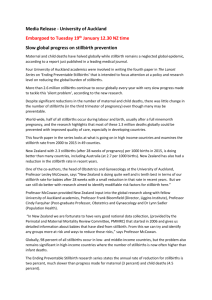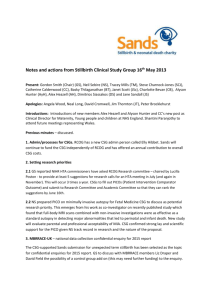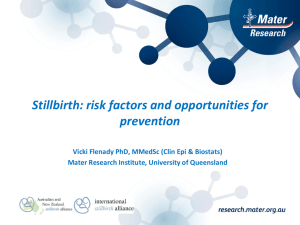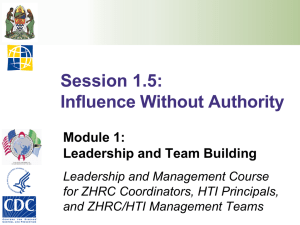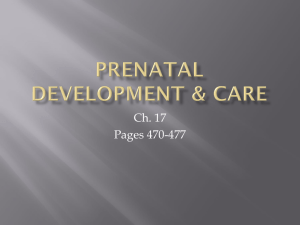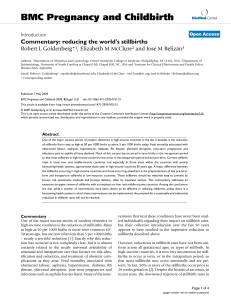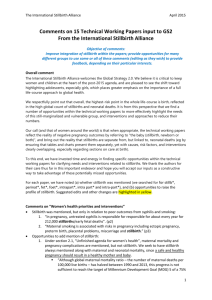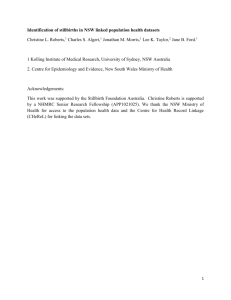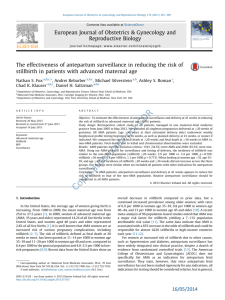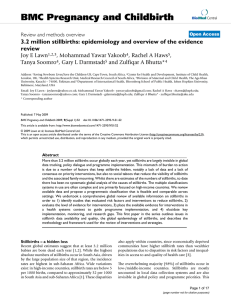Prevention of Stillbirth in High Income Countries
advertisement
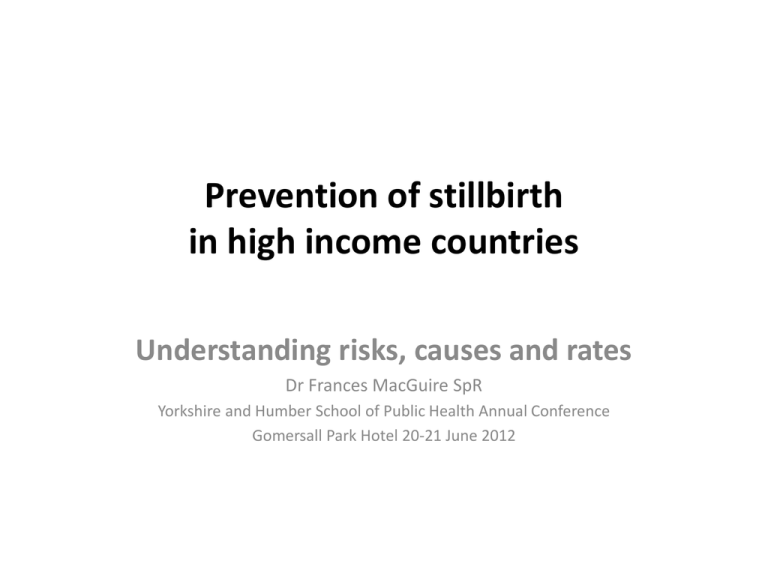
Prevention of stillbirth in high income countries Understanding risks, causes and rates Dr Frances MacGuire SpR Yorkshire and Humber School of Public Health Annual Conference Gomersall Park Hotel 20-21 June 2012 Overview • • • • • Why stillbirth matters Outline of MPH research Causes and risks for stillbirth Bradford rates and the BiB cohort Next steps Stillbirth is not a rare event, globally…nor in the UK • • • • • • • ~ 3 million babies stillborn every year, 98% LI/MI countries WHO: “most stillbirths are avoidable” 2011 Lancet series: UK ranked 33/35 similar HI countries UK: one in every 200 babies stillborn Rate of stillbirth unchanged since 1990s – 5.2/1000 births in 2009 CMO: 500 intrapartum deaths/yr “major public health issue” NHS Outcomes Framework Impact on parents, clinicians, services • Profound impact on parents and families o Isolating form of bereavement – invisible, taboo o Risk of severe psychological reactions o 40% higher risk of relationship breakdown & reduced income • Clinicians o 1 in 10 obstetricians considered giving up practice (RCOG) • Healthcare system o Future pregnancies high risk – more intervention (us scans, CS) o 50% of all negligence costs intrapartum-care related ~ NHSLA £328 million 2010/11, 1 billion over 5 years MPH dissertation: Evidence base Structured literature reviews of guidelines and systematic reviews on prevention • No systematic reviews or guidelines to specifically prevent stillbirth • Two Cochrane reviews underway on interventions for: – preventing stillbirth – supporting parents decisions about post mortem 2011 Lancet series “Each geographical area must understand the local causes of and risk factors for stillbirth and the contexts in which they occur…so that appropriate prevention strategies can be developed and implemented” Cause of death – difficult to determine but important • For the parents: – helps with grieving, understanding risks • For clinicians: – understanding risks, changing clinical practice. • Efforts to identify cause of death “inadequate” • Cause of death unexplained 50% cases • Best practice: high-quality post-mortem Major causes of death Flenady et al., (2011) Retrospective 8 country cohort study of stillbirths and neonatal deaths. The Lancet •Placental pathologies •Infection •Cord incidents •Pre-existing maternal conditions e.g. diabetes •Congenital anomalies •Intrapatrum complications e.g. breech •Unexplained, most unexplored 25% 12% 9% 7% 6% 3% 30% Risk factors for stillbirth • • • • • • • • • • • • • • Maternal age (under 20 and over 35) First pregnancy (nulliparity) Pre-existing conditions e.g. diabetes, hypertension Placental abruption Small size for gestational age Use of IVF Multiple pregnancy Post-term pregnancy Previous stillbirth or caesarian Deprivation Ethnicity Obesity Lifestyle – smoking, alcohol, drug use Adequacy of antenatal and intrapartum care Born in Bradford • Stillbirth rates higher than E&W average 7.5/1000 • Retrospective case series of babies stillborn in the Born in Bradford cohort • Exploration of local rates, causes and risks to inform prevention strategies at a local level 10 Rate per 1000 live + stillbirths 9 8 7 6 5 4 3 2 1 0 19931995 19941996 19951997 19961998 19971999 19982000 Bradford 19992001 20002002 20012003 20022004 20032005 20042006 20052007 20062008 20072009 England & Wales Calendar Years StillBirth 1993-1995 1994-1996 1995-1997 1996-1998 1997-1999 1998-2000 1999-2001 2000-2002 2001-2003 2002-2004 2003-2005 2004-2006 2005-2007 2006-2008 2007-2009 Bradford No. deaths 151 153 144 129 135 142 163 158 162 169 192 192 198 178 187 Bradford Rate 6.8 7.0 6.7 6.1 6.3 6.6 7.6 7.3 7.3 7.5 8.2 8.0 8.0 7.1 7.3 Eng & Wales Rate 5.6 5.6 5.4 5.4 5.3 5.3 5.3 5.4 5.6 5.7 5.6 5.5 5.3 5.2 5.1 Source: NHS Bradford and Airedale Figure 1. Stillbirth rate in 3 year rolling periods Bradford’s stillbirth rate is consistently higher and more variable than the England and Wales (E&W) average, which declined slightly from 1993-2009. Bradford’s rates were higher in 2009 than during the early 1990s. Mortality rates for premature and full term births, 1996-2009 6 Mortality rate per 1000 births 5 4 Neonatal Postneonatal 3 Infant Still birth 2 1 0 1996- 1997- 1998- 1999- 2000- 2001- 2002- 2003- 2004- 20052000 2001 2002 2003 2004 2005 2006 2007 2008 2009 Premature 1996- 1997- 1998- 1999- 2000- 2001- 2002- 2003- 2004- 20052000 2001 2002 2003 2004 2005 2006 2007 2008 2009 Full term Source: NHS Bradford and Airedale Figure 2. Neonatal, postneonatal, infant and stillbirth mortality rates in Bradford District, 1996-2009 Born in Bradford • • • • Cohort – 13,776 total births 68 babies stillborn, 30 male, 36 female 28 (41.2%) premature, 40 (58.8%) term Of term babies • 28 between 37 and 39+6 weeks • 5 at 40+0 • 7 at 41+0 and over Higher proportion of term babies reflects District findings, contrasts with national data – 1/3 stillbirths at term Cause of death: P95 – “fetal death of unspecified cause” • 187 stillbirths Jan 07 to Dec 09 • Primary COD P95 for 96 records - 70% cases • Of 55 cases with a primary diagnosis • 5 cases premature separation of placenta • <5 cases each for hypertension, slow fetal growth, anencephaly • 14 cases – congenital anomalies and trisomies Cause of death • • • • Available for only 32 out of 68 cases (47.1%) Data only available to 2009 25 cases, 78% coded P95 Of 19 term cases, 18 coded P95 Next steps In discussions with BRI about: – how to reduce rates – use of CTG and ultrasound amniotic fluid measurement in monitoring of pregnancies over 41+0 weeks – investigation for thrombophilia where stillbirth remains unexplained following core investigations Acknowledgements Professor Mary Renfrew, Dr Alison McFadden, Dr Stephen Oliver, Professor Hilary Graham, Dr Shirley Brierley, Dr Helen Brown, Teresa Keegan and Simon Chappell, Dr John Wright, Professor Neil Small, Professor Derek Tufnall, Dr Sam Oddie, Dr Pauline Raynor, Shaeen Ahktar, Dawn Jankowicz, Neil Garside. References • • • • • • • Bahtiyar, M.O., Funai, E.F., Rosenberg, V., Norwitz, E., Lipkind, H., Buhimschi, C. and Copel, J.A. (2008). Stillbirth at term in women of advanced maternal age in the United States: when could the antenatal testing be initiated. American Journal of perinataology 25 (5), 301-4. Balchin, I., Whittaker, J.C., Patel, R.R., Lamont, R.F. and Steer, P. (2007). Racial variation in the association between gestational age and perinatal mortality: prospective study. BMJ 334. Flenady, V. and Wilson, T. (2011). Support for mothers, fathers and families after perinatal death. Cochrane Database of Systematic Reviews 2008, (1). Cochrane Database of Systematic Reviews 2008, Issue 1. Art. No.: CD000452. DOI: 10.1002/14651858.CD000452.pub2. Flenady, V., Middleton, P., Smith G.C., Duke W., Erwich, J.J., Yee Khong, T., Neilson, J., Ezzati, M., Koopmans, L., Ellwood, D., Fretts, R., and Frøen, J.F. (2011b). Stillbirths: the way forward in high-income countries. Lancet 377, (9774). Gordon, A. and Jeffrey, H.E. (2008). Classification and description of stillbirths in NSW, 2002-2004. The Medical Journal of Australia 118 (11), 645-648. Available at: http://www.mja.com.au/public/issues/188_11_020608/gor10947_fm.html. [Accessed 24 May, 2011]. Perinatal Society of Australia and New Zealand (PSANZ) (2009). Clinical Practice Guideline for Perinatal Mortality. Available at: http://psanz.com.au/special-interest-groups/pnm.aspx. [Accessed 7 September, 2009]. Royal College of Obstetricians and Gynaecologists (2011). Obstetric choleostasis. Green-top Guideline No.43. London: RCOG.

